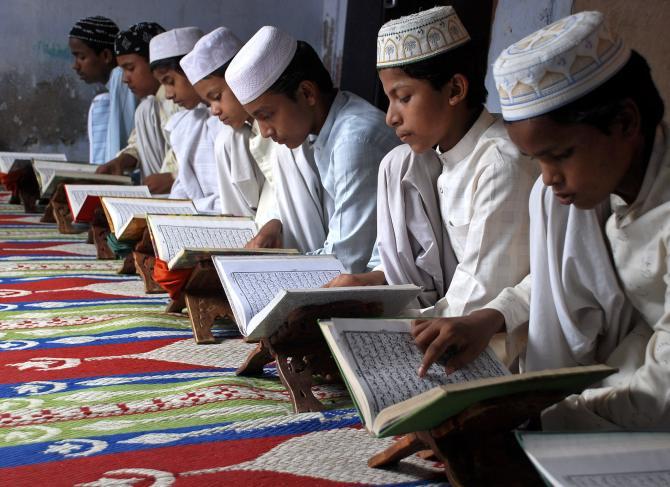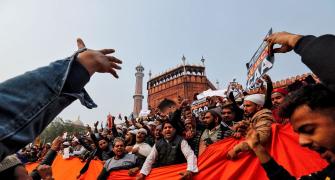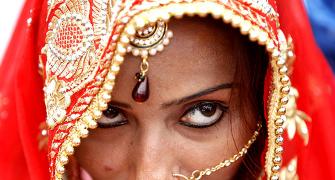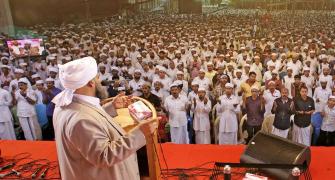'In the Middle Ages, when Muslims were around 15 per cent of the population of the world, they accounted, according to one estimate, for 90 per cent of scientific advancements.'
'And today, when Muslims are around 22 per cent of the population of the world, their share in scientific writings is less than 1 per cent!' point out Ziya Us Salam and M Aslam Parvaiz.

Today, Muslims across the world are divided on the basis of ethnicity, language, sect and so on but, at the risk of making a broad generalisation, one can say that, by and large, they share a common feature: And that is, a distinct absence of the scientific spirit and low levels of scientific achievement and awareness.
This is true, generally speaking, of Muslims across the world, especially in South Asia, which is home to the largest concentration of Muslims in the world.
The low level of interest in and awareness about science among Muslims generally is, in part, a result of their long-established educational system.
Here the question arises: What sort of education and educational system are we talking about that is responsible for this malaise?
If the fault lies with the secular education that is imparted in 'modern' schools, then one can ask why is it that people of other faiths who are also part of this educational system are advancing in science while Muslims are not?
And if the fault lies in what is called the deeni or religious education that is imparted in madrasas, and if it be said that such education is inimical or indifferent to a scientific attitude, then one can ask how was it possible that for a long period, from the 7th to the 12th century, Muslim scientists who were products of this sort of education made great advances that laid the foundations of modern science?
There have been periods in human history when only religious learning was considered as education.
People thought that through religious education they could acquire what the needed in order to be educated for their well-being.
Here we should remember that knowledge has two sources: the first is revealed knowledge based on divine revelation.
The second is the Book of Nature -- the world around us, from which knowledge of nature can be drawn.
In the beginning of human history, the only source of knowledge was divine revelation or wahi Ilahi.
The teachings, including laws and rules, given by God were conveyed to humanity through prophets.
This was then the only way for education and training.
The Quran refers to this way of providing knowledge in several places.
As the human population increased and the social structure became more complex, God arranged for new ways and methods for people to acquire knowledge.
Thanks to the efforts of many thinkers, over time new disciplines or sciences came into being and their scope expanded.
It is widely recognised that for a long period, till the 12th century, Muslims were in the forefront of scientific scholarship, discoveries and inventions.
In this era, many of the greatest philosophers, mathematicians, doctors and historians were Muslims.
An important contribution of these early Muslim scholars was the experimental method, which is integral to modern science.
The great interest in knowledge and research that emerged with the rise of Islam is a significant phenomenon.
This thirst for knowledge among the early Muslims was produced by the Quran and by the encouragement given to knowledge by the Prophet Muhammad.
Practising the teachings of the Quran, these Muslims became experts in many sciences and made significant advances in them, which was a major reason for the widespread Muslim influence that prevailed at this time over a large part of the world.
This continued till around the 12th century or so.
But after this, Muslims slipped into the same sort of 'Dark Ages' that Europe slumbered in during the period of Muslim dominance, with the rise of superstition and anti-scientific attitudes.
Increasingly, Muslims began treating knowledge of the world as useless.
This was in sharp contrast to their attitude to science in their early history.
It is something that even noted ulemma in India have also said more than once in the days gone by.
For instance, well respected Deobandi intellectual, Ashraf Ali Thanwi, stated, that it is, in fact, a source of great pride for the religious madrasas not to impart any secular education at all. For if this is done, the religious character of these madrasas would inevitably be grievously harmed.
Some say that madrasas should teach their students additional subjects that would help them earn a livelihood, but this is not the aim of the madrasa at all.
The madrasa is actually meant for those who have gone mad with their concern for the hereafter.
In contrast to this, an important aspect of the passion for knowledge among early Muslims was their holistic understanding of knowledge.
Many of the top Muslim scientists of this time were not just experts in one or the other natural science but also in the religious sciences.
Al-Kindi was a scholar of Islam and an expert in subjects like music and mathematics.
In a study of key scientists from the 7th to the 15th century, Charles Gillespie made a list of 132 people, of whom 105 were from the Muslim world.
Many of the others who were from Europe had studied science in institutions in Muslim Spain.
This means that around 90 per cent of the top scientists of this time were from the Muslim world.
How things have changed since then!
In a survey done in 1981, it was found that among the top 25 countries as far as publication of scientific literature annually is concerned, not one was Muslim!
In 1996, less than 1 per cent of the authors of scientific articles published in journals across the world were Muslims!
In the Middle Ages, when Muslims were around 15 per cent of the population of the world, they accounted, according to one estimate, for 90 per cent of scientific advancements.
And today, when Muslims are around 22 per cent of the population of the world, their share in scientific writings is less than 1 per cent!
That is one measure of the level and extent of Muslim decline.

There was a time when in Baghdad, on just one street, there were some 200 bookshops, with books on subjects ranging from the Quran to astronomy, biology, mathematics and chemistry.
People had personal libraries in their homes, and lovers of knowledge would organise literary sessions.
The Quran was studied in the light of new discoveries and sciences.
But today, leave alone Muslim bookshops or personal collections, it is difficult to find books by Razi or Jabir bin Hayyam or al-Kindi even in the libraries of Muslim educational institutions!
This story of Muslim decline in the field of scientific education is a dark chapter of human history.
A community that made great contributions to science became a victim to blind imitation and hidebound traditionalism, because of which it fell behind in the field of science and technology.
They stopped inventing useful things, and confined themselves to memorisation of the sacred verses without understanding their meaning or the spirit behind them.
A principal factor that attracted many early Muslims to engage in research to study Nature was undoubtedly the Quran.
At that time, the Quran was the Muslims's only focal point and they were blessed by being in the company of the Prophet, from whom they received guidance.
But after the demise of the Prophet, the situation began to change.
This transformation happened slowly and in different ways.
The Caliphate was replaced by authoritarian monarchy.
Muslims began fighting among themselves.
In this period, hadiths of the Prophet began being collected.
Different views emerged regarding their status and authenticity and chains of transmission.
Jurisprudential disputes and sectarian differences led to severe conflicts.
New lands came under Muslim rule and while some people accepted Islam truly, some others did so for some worldly interest and to curry favour with the new rulers.
At this time, some minds among the peoples whom the Muslims had vanquished reflected on the causes of Muslim dominance and thought of ways to put an end to it.
It did not take them long to understand that it was the Quran -- and only the Quran -- that had united those who believed in it and in whose light of guidance they had become experts in many fields of knowledge and a powerful military, economic, social, political and civilisational force.
These opponents of Islam also understood that it was impossible to make any changes in the Quran. So, they adopted a different method.
In a very organised way, using different means, they sought to try to shift the Muslims's attention away from the Quran onto other things and to divert their thinking, concerns, efforts and abilities to other issues.
Excerpted from Madrasas In The Age Of Islamophobia by Ziya Us Salam and M Aslam Parvaiz, with the kind permission of the publishers, Sage Publications India Pvt Ltd.








